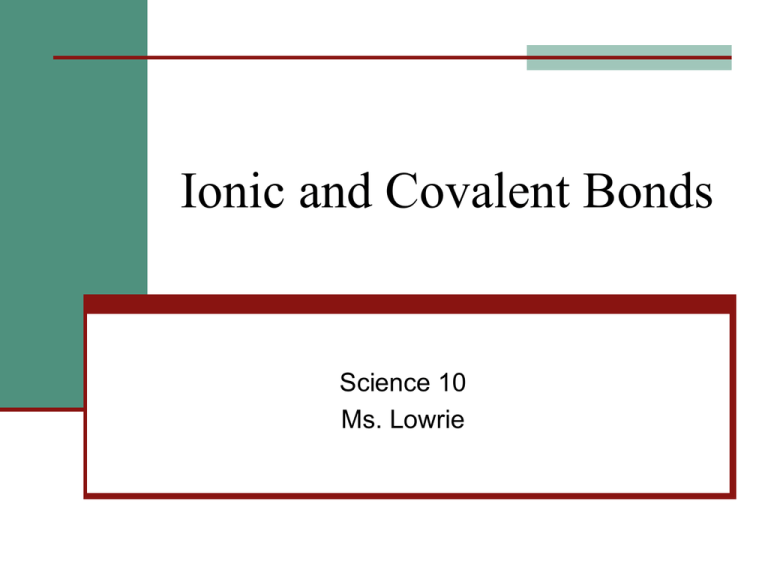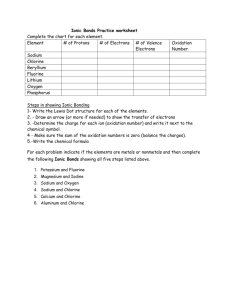Ionic and Covalent Bonds
advertisement

Ionic and Covalent Bonds Science 10 Ms. Lowrie Using Lewis Diagrams to Show: Covalent Bonding Steps: 1. 2. 3. 4. Draw a Lewis diagram for both elements Determine how to fill valance shell of both by sharing electrons Redraw Lewis diagrams together Circle ‘shared’ electrons Covalent Examples a) Hydrogen (H) and Chlorine (Cl) b) Water = Hydrogen (H) and Oxygen (O) More Covalent Examples c) Carbon (C) and Hydrogen (H) d) Fluorine (F) and Fluorine (F) e) Phosphorus (P) and Chlorine (Cl) f) Carbon (C) and Chlorine (Cl) Practice: Draw Covalent Bonds 1. Hydrogen and Hydrogen 2. Ammonia = Hydrogen and Nitrogen 3. Chlorine and Chlorine 4. Nitrogen and Fluorine 5. Oxygen and Chlorine 6. Hydrogen and Fluorine 7. Iodine and Iodine 8. Carbon and Fluorine Using Lewis Diagrams to Show: Ionic Bonding Steps: 1. 2. Draw a Lewis diagram for each element Use arrows to show how the electrons move Example (a): Potassium (K) and chlorine (Cl) More Ionic Examples b) Sodium (Na) and oxygen (O) c) Calcium (Ca) and chlorine (Cl) d) Barium (Ba) and fluorine (F) e) Aluminum (Al) and Oxygen (O) Practice: Draw Ionic Bonds 1. Potassium and Phosphorus 2. Sodium and Fluorine 3. Aluminum and Chlorine 4. Potassium and Fluorine 5. Lithium and Oxygen 6. Calcium and Phosphorous 7. Sodium and Nitrogen 8. Aluminum and Bromine Writing Chemical Formulas Crossover Method Shortcut to writing ionic compound formulas Steps: 1. 2. Determine ions (write cation first) “Crossover” - Write ion # as subscript (bottom #) for other element Notes: Do not write +1 Write -1 as If charges are equal (+2 & -2) = 1 each Crossover Method – Example a) Barium and Chlorine BaCl2 More Crossover Examples b) Beryllium and Phosphorous More Crossover Examples c) Potassium (K) and Phosphorous (P) d) Sodium (Na) and Fluorine (F) e) Aluminum (Al) and Oxygen (O) f) Potassium (K) and Fluorine (F) Practice: Crossover Method 1. Lithium and Oxygen 2. Calcium and Phosphorous 3. Calcium and Chlorine 4. Aluminum and nitrogen 5. Beryllium and Oxygen 6. Beryllium and Nitrogen 7. Potassium and Sulphur 8. Sodium and Oxygen Practice Worksheets 1. “Ionic vs. Covalent Bonds” Last 2 questions 2. “Write formulas for the following:” Using Crossover Method Polyatomic Ions Ions made up of 2+ ions “poly” = many Polyatomic Ion Formulas Notes on formula writing: Use brackets to keep polyatomic ion “together” Write cation first Example a) Write formula for: NH41+ and S21. Draw: 2. Use Crossover Method: Examples & Practice b) Calcium & Nitrate c) Sodium & Hydroxide d) Sodium & Sulfate e) Calcium & Phosphate f) Lithium & Hydrogen carbonate Practice Worksheets 1. “Polyatomic Ion Practice” 2. “Writing Formulas” No naming yet! Naming Ionic Compounds Steps: 1. 2. Write cation first Write anion last with suffix (ending) “ide” Potassium Chloride Note: Do not include ‘numbers’! Naming Ionic Compounds: Examples a) Ba and Cl b) Sodium and Fluorine c) Be and P d) Ca2+ and Cle) Al3+ and N3f) Na2O g) K3P Naming Ionic Compounds: Practice 1. Be2+ and O2- Polyatomic Ions: 2. Be2+ and N3- 3. K+ and S2- Same “ordering” rule! Don’t change to “ide” 4. Al2O3 1. Ca & NO3 5. KF 2. Na & OH 6. Li2O 3. Na & SO4 7. Ca3P2 4. Ca & PO4 5. Li & HCO3 Naming Ionic Compounds: Practice 1. “Writing Formulas” worksheet With names now! Complete the following textbook questions: #9, 10 (on page 113) #2 (pg 115) #4 (on pg 117) Naming Covalent Compounds Steps: 1. Add numerical prefix (beginning) to both elements 2. Ignore ‘mono’ for 1st element Add “ide” suffix (ending) to second element Note: When prefix ending in O or A is added to oxide, drop last vowel of prefix Naming Covalent Compounds: Examples 1 mono 2 di 3 tri 4 tetra 5 penta 6 hexa 7 hepta 8 octa 9 nona 10 deca * Second element in ‘ide’ from * Drop –a & -o before ‘oxide’ a) N2S4 dinitrogen tetrasulfide b) NI3 nitrogen triiodide c) XeF6 xenon hexafluoride d) CCl4 carbon tetrachloride e) P2O5 diphosphorus pentoxide f) SO3 sulfur trioxide Naming Covalent Compounds: Practice “Nomenclature – Covalent Compounds” worksheet Complete the following textbook questions: #9, 10 (on page 123)



